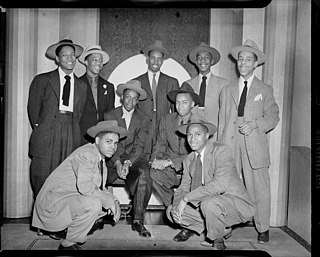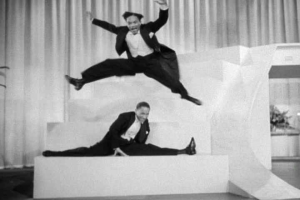
Cabell Calloway III was an American jazz singer and bandleader. He was a regular performer at the Cotton Club in Harlem, where he became a popular vocalist of the swing era. His niche of mixing jazz and vaudeville won him acclaim during a career that spanned over 65 years.

The V sign is a hand gesture in which the index and middle fingers are raised and parted to make a V shape while the other fingers are clenched. It has various meanings, depending on the circumstances and how it is presented.

A zoot suit is a men's suit with high-waisted, wide-legged, tight-cuffed, pegged trousers, and a long coat with wide lapels and wide padded shoulders. It is most notable for its use as a cultural symbol among the Hepcat and Pachuco subcultures. Originating among African Americans it would later become popular with Mexican, Filipino, Italian, and Japanese Americans in the 1940s.

The jive is a dance style that originated in the United States from African Americans in the early 1930s. The name of the dance comes from the name of a form of African-American vernacular slang, popularized in the 1930s by the publication of a dictionary by Cab Calloway, the famous jazz bandleader and singer. In competition ballroom dancing, the jive is often grouped with the Latin-inspired ballroom dances, though its roots are based on swing dancing and not Latin dancing.

The high five is a hand gesture that occurs when two people simultaneously raise one hand and slap the flat of their palm against the other. The gesture is often preceded verbally by a phrase like "Give me five", "High five", or "Up top". Its meaning varies with the context of use but can include as a greeting, congratulations, or celebration.

The Nicholas Brothers were an entertainment act composed of brothers, Fayard (1914–2006) and Harold (1921–2000), who excelled in a variety of dance techniques, primarily between the 1930s and 1950s. Best known for their unique interpretation of a highly acrobatic technique known as "flash dancing", they were also considered by many to be the greatest tap dancers of their day, if not all time. Their virtuoso performance in the musical number "Jumpin' Jive" featured in the 1943 movie Stormy Weather has been praised as one of the greatest dance routines ever captured on film.

Harold Lloyd Nicholas was an American dancer specializing in tap. Nicholas was the younger half of the tap-dancing pair the Nicholas Brothers, known as two of the world's greatest dancers. His older brother was Fayard Nicholas. Nicholas was featured in such musicals as An All-Colored Vaudeville Show (1935), Stormy Weather (1943), The Pirate (1948), and The Five Heartbeats (1991).

A fist bump (also known as a bro fist, power five, a spud or also commonly known as a safe is a gesture similar in meaning to a handshake or high five. A fist bump can also be a symbol of giving respect or approval, as well as companionship between two people. It can be followed by various other hand and body gestures and may be part of a dap greeting. It is commonly used in sports as a form of celebration with teammates and with opposition players at the beginning or end of a game. Fist bumps are often given as a form of friendly congratulation.
David Albert "Panama" Francis was an American swing jazz drummer who played on numerous hit recordings in the 1950s.

The Juba dance or hambone, originally known as Pattin' Juba, is an African-American style of dance that involves stomping as well as slapping and patting the arms, legs, chest, and cheeks (clapping). "Pattin' Juba" would be used to keep time for other dances during a walkaround. A Juba dance performance could include steps such as the "Jubal Jew", "Yaller Cat", "Pigeon Wing" and "Blow That Candle Out".

Stormy Weather is a 1943 American musical film produced and released by 20th Century Fox, adapted by Frederick J. Jackson, Ted Koehler and H.S. Kraft from the story by Jerry Horwin and Seymour B. Robinson, directed by Andrew L. Stone, produced by William LeBaron and starring Lena Horne, Bill "Bojangles" Robinson, and Cab Calloway. The film is one of two Hollywood musicals with an African American cast released in 1943, both starring Lena Horne, the other being MGM's Cabin in the Sky. Stormy Weather is a primary showcase of some of the leading African American performers of the day, during an era when African American actors and singers rarely appeared in lead roles in mainstream Hollywood productions. The supporting cast features the Nicholas Brothers in arguably the screen's most bravura dance sequence, Fats Waller, Katherine Dunham and her dancers, and Dooley Wilson. Stormy Weather takes its title from the 1933 song of the same title, which is performed almost an hour into the film. It is loosely based upon the life and times of its star, dancer Bill "Bojangles" Robinson.

The Old Man of the Mountain is a 1933 American pre-Code live-action/animated short in the Betty Boop series, produced by Fleischer Studios. Featuring music by Cab Calloway and his Orchestra, the short was originally released to theaters on August 4, 1933 by Paramount Pictures. Calloway voices all of the characters in the cartoon save for Betty herself. Calloway and his orchestra also perform all of the music in the cartoon, including two songs Calloway co-wrote.
"Jumping Jive" is a famous jazz/swing composition, written by Cab Calloway, Frank Froeba, and Jack Palmer. Originally recorded on 17 July 1939, on Vocalion Records, it sold over a million copies and reached #2 on the Pop chart. Calloway performs the song with his orchestra and the Nicholas Brothers in the 1943 musical film Stormy Weather.

The terms hipster or hepcat, as used in the 1940s, referred to aficionados of jump blues and jazz, in particular bebop, which became popular in the early 1940s. The hipster subculture adopted the lifestyle of the jazz musician, including some or all of the following features: Conk hairstyles, loose fitting suits with loud colors, jive talk slang, use of tobacco, cannabis, and recreational drugs, relaxed attitude, love for Jazz or Jump blues music, and styles of swing dancing, especially Lindy hop.
Flash dancing was a form of tap dance that evolved in the 1920s–1930s, which combined dance with acrobatics. Prominent flash dance acts of the time include the Nicholas Brothers, The Four Step Brothers and the Berry Brothers.

A facepalm is the physical gesture of placing one's hand across one's face, lowering one's face into one's hand or hands or covering or closing one's eyes. The gesture is often exaggerated by giving the motion more force and making a slapping noise when the hand comes in contact with the face. The gesture is found in many cultures as a display of frustration, disappointment, exasperation, embarrassment, horror, shock, surprise, exhaustion, sarcasm, shame, or incredulous disbelief.
Johnny Letman was an American jazz trumpeter.
Frank Froeba or Froba was an American jazz pianist and bandleader.
Jive talk, also known as Harlem jive or simply Jive, the argot of jazz, jazz jargon, vernacular of the jazz world, slang of jazz, and parlance of hip is an African-American Vernacular English slang or vocabulary that developed in Harlem, where "jive" (jazz) was played and was adopted more widely in African-American society, peaking in the 1940s.
Ernestine Carroll Davis, better known as Tiny Davis, was an American jazz trumpeter and vocalist.














